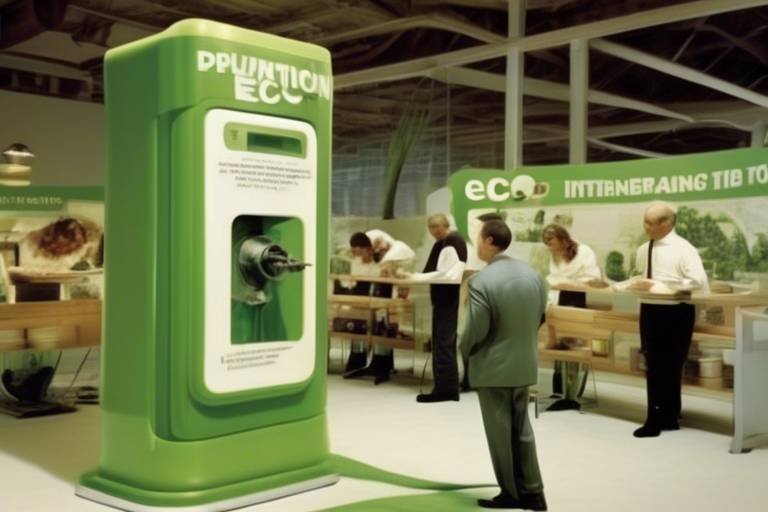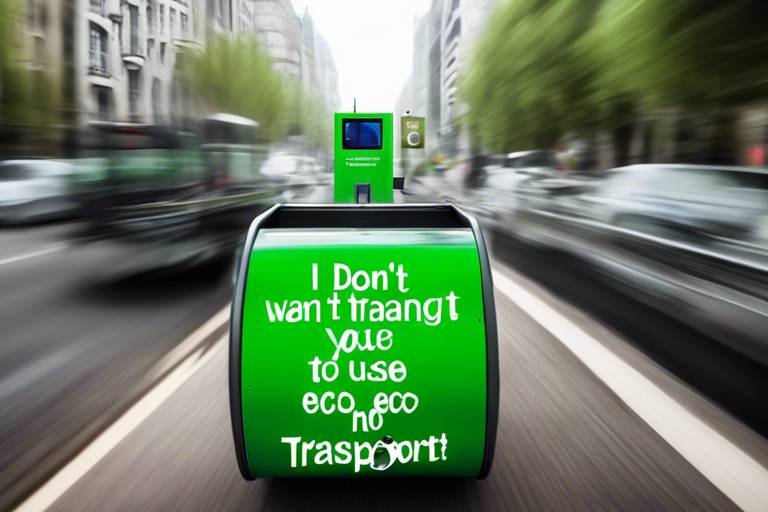Can Eco-Friendly Products be High Quality?
In today's world, where sustainability is becoming a buzzword, many consumers find themselves asking, “Can eco-friendly products really be high quality?” This question is not just a passing thought; it's a significant consideration for anyone looking to make responsible purchasing decisions. Eco-friendly products are often perceived as being less effective or durable compared to their conventional counterparts. However, this perception doesn't always hold true. In fact, many eco-friendly products are designed with innovation and quality in mind, challenging the age-old belief that sustainability compromises performance.
To fully understand this relationship between eco-friendliness and quality, we need to explore several key areas. First, we must examine the materials used in these products, as they play a crucial role in determining both sustainability and performance. Next, we will delve into the certifications that can guide consumers in identifying high-quality eco-friendly options. Finally, real-life consumer experiences will help us paint a clearer picture of what it means to choose sustainability without sacrificing quality.
As we embark on this exploration, it's essential to keep an open mind. The world of eco-friendly products is not just about being green; it's about innovation, quality, and responsibility. By the end of this article, we hope to answer the question definitively and perhaps even change the way you view eco-friendly products forever.
Consumer perceptions play a crucial role in the acceptance of eco-friendly products. Many people still hold the belief that eco-friendly means inferior quality. This misconception can stem from past experiences with products that didn’t perform as well as expected. However, it’s essential to recognize that just like any other category of products, there are high-quality and low-quality options in the eco-friendly market. The key is to look beyond the green label and consider the actual performance and materials used.
Furthermore, marketing plays a significant role in shaping these perceptions. Companies that prioritize sustainability often highlight their eco-friendly practices, but they must also ensure that their products deliver on performance. As consumers become more educated about sustainability, they are starting to demand both quality and eco-friendliness, leading brands to innovate and improve their offerings. This shift in consumer expectations is paving the way for a new era of eco-friendly products that do not compromise on quality.
When it comes to eco-friendly products, the choice of materials is paramount. Sustainable materials not only contribute to a lower environmental impact but also affect the overall quality of the products. For instance, many eco-friendly brands are turning to natural materials such as bamboo, organic cotton, and hemp, which often outperform synthetic alternatives in terms of durability and comfort. However, it’s essential to analyze the effectiveness of these materials in maintaining high performance.
Natural materials have a reputation for being more sustainable, but they come with their own set of challenges. For example, while organic cotton is biodegradable and free from harmful chemicals, it may not always be as durable as synthetic fibers like polyester. On the other hand, synthetic materials can offer excellent durability and performance but often come with a significant environmental cost. This raises the question: Can we find a middle ground? The answer lies in innovation, with many brands now blending natural and synthetic materials to create products that are both sustainable and high quality.
Biodegradable materials are often touted as eco-friendly, but how do they hold up in terms of quality? These materials break down over time, which is great for the environment, but they can sometimes lack the longevity of traditional materials. For instance, biodegradable plastics may not withstand the same wear and tear as their conventional counterparts. However, advancements in technology are leading to the development of biodegradable materials that are both functional and sustainable. This evolution is crucial as consumers seek products that do not only help the planet but also meet their performance expectations.
Recycled materials are increasingly used in eco-friendly products, contributing to sustainability efforts while also raising questions about quality. While recycling helps reduce waste and resource consumption, the quality of recycled materials can vary significantly. For example, recycled polyester can be just as durable as virgin polyester, but it may come with some limitations in terms of color and texture. Understanding these nuances helps consumers make informed choices about the products they select.
Certifications can indicate the quality and sustainability of eco-friendly products. Various organizations provide certifications that help consumers identify products that meet specific environmental and quality standards. For instance, the Global Organic Textile Standard (GOTS) ensures that textiles are made from organic fibers and processed sustainably. Similarly, the Forest Stewardship Council (FSC) certifies that wood and paper products come from responsibly managed forests. These certifications serve as a guide for consumers seeking high-quality eco-friendly options, providing peace of mind that their purchases are both sustainable and effective.
Real-life experiences can provide invaluable insight into the quality of eco-friendly products. Many consumers share their thoughts and reviews online, helping others make informed decisions. For example, numerous testimonials highlight how eco-friendly cleaning products not only work as effectively as traditional cleaners but often outperform them in terms of safety and environmental impact. These experiences are crucial for building trust in the eco-friendly market.
Several eco-friendly brands have established themselves as leaders in quality and sustainability. Brands like Patagonia and Seventh Generation have garnered positive consumer feedback for their commitment to both high-quality products and environmental responsibility. By focusing on transparency and ethical practices, these companies have set a standard that others aspire to achieve.
Despite their advantages, eco-friendly brands face challenges in quality assurance. Issues such as sourcing sustainable materials and maintaining consistent production standards can hinder quality. However, many brands are actively working to overcome these challenges by investing in research and development, ensuring that their products meet both sustainability and performance expectations.
- Are eco-friendly products always more expensive? While some eco-friendly products may have a higher upfront cost, they often provide long-term savings due to their durability and effectiveness.
- How can I identify high-quality eco-friendly products? Look for certifications, read consumer reviews, and research the materials used in the products.
- Do eco-friendly products perform as well as traditional products? Many eco-friendly products are designed to match or exceed the performance of traditional options, so it’s essential to evaluate each product individually.

The Perception of Eco-Friendly Products
When it comes to eco-friendly products, consumer perceptions can be as varied as the products themselves. Many people have a preconceived notion that these sustainable alternatives are of lower quality compared to their traditional counterparts. This belief often stems from the idea that if something is made with less harmful materials, it must also be less effective or durable. However, this perception is not always accurate, and it’s essential to dissect the common beliefs and misconceptions surrounding eco-friendly products.
For instance, consider the analogy of a classic car versus a modern electric vehicle. While the classic car might evoke nostalgia and charm, the electric vehicle offers advanced technology and efficiency. Similarly, eco-friendly products can provide performance that rivals or even surpasses traditional options. The challenge lies in shifting consumer mindsets to recognize that sustainability does not equate to compromise.
Moreover, many consumers are influenced by marketing messages that portray eco-friendly products as “good for the planet,” which can inadvertently lead to skepticism about their effectiveness. This skepticism can be compounded by experiences where consumers have tried eco-friendly alternatives that didn’t meet their expectations. Is it possible that some eco-friendly products are genuinely subpar? Yes, but that doesn’t mean all are. The key is to look beyond the label and understand the materials and certifications behind the product.
Additionally, social influence plays a significant role in shaping perceptions. As more people become aware of environmental issues, there’s a growing trend towards supporting brands that prioritize sustainability. This shift in consumer behavior can create a positive feedback loop, where the demand for high-quality eco-friendly products encourages companies to innovate and improve their offerings. In fact, many brands are now leveraging this trend by highlighting their commitment to both quality and sustainability in their marketing.
To further illustrate this point, let’s take a look at some common misconceptions:
- Eco-friendly products are always more expensive: While some sustainable products may carry a higher price tag, many affordable options are available that do not sacrifice quality.
- They don’t work as well: Numerous studies and consumer reviews indicate that many eco-friendly products perform just as well, if not better, than traditional ones.
- They are not durable: Advances in technology have led to the development of eco-friendly materials that are both durable and effective.
In conclusion, the perception of eco-friendly products is evolving. As consumers become more educated about the benefits of sustainability, they are beginning to appreciate that quality and environmental responsibility can coexist. It’s crucial for brands to communicate their values and the quality of their products effectively to bridge the gap between perception and reality.

Materials Used in Eco-Friendly Products
When it comes to eco-friendly products, the choice of materials is not just a matter of preference; it’s a cornerstone of their quality and effectiveness. Many people often wonder, “Are these materials really as good as traditional options?” The answer is a resounding yes, but it’s essential to dive deeper into the types of materials used in these products to understand their true potential. From natural fibers to innovative recycled materials, the landscape of eco-friendly materials is as diverse as it is fascinating.
One of the most significant advantages of eco-friendly products is their use of sustainable materials that minimize environmental impact. For instance, materials like bamboo and organic cotton are gaining popularity due to their renewable nature and lower carbon footprints. These materials not only offer durability but also provide a level of performance that can rival conventional products. Take bamboo, for example; it grows rapidly and requires minimal resources, making it a fantastic alternative to traditional wood and textiles.
On the flip side, we have synthetic materials that have been re-engineered to be more sustainable. These include recycled plastics and fabrics made from post-consumer waste. While some might argue that synthetic materials are less eco-friendly due to their petroleum origins, advancements in technology have made it possible to create high-quality, durable products that significantly reduce waste. For instance, recycled polyester can be just as strong and versatile as virgin polyester, but with a fraction of the environmental impact.
The debate between natural and synthetic materials in eco-friendly products can often feel like choosing between apples and oranges. Each has its unique set of benefits and drawbacks. Natural materials, such as hemp and organic cotton, tend to be biodegradable and have a lower ecological footprint. However, they may not always offer the same level of durability as their synthetic counterparts. On the other hand, synthetic materials can provide enhanced performance, particularly in outdoor gear and clothing, but their environmental impact during production and disposal cannot be overlooked.
To give you a clearer picture, here’s a quick comparison:
| Material Type | Pros | Cons |
|---|---|---|
| Natural Materials |
|
|
| Synthetic Materials |
|
|
Biodegradable materials are often heralded as the champions of sustainability. These materials break down naturally over time, returning to the earth without leaving harmful residues. Products made from biodegradable materials, such as compostable bioplastics and organic textiles, can significantly reduce landfill waste. However, the question arises: how do these materials stack up in terms of quality and longevity? While they may not last as long as traditional materials, their environmental benefits often outweigh the drawbacks, especially for single-use items.
Recycled materials are another exciting avenue in the realm of eco-friendly products. Brands are increasingly utilizing recycled plastics, metals, and textiles to create new items, effectively giving waste a second life. This not only diverts materials from landfills but also conserves natural resources. However, consumers might wonder about the quality of products made from recycled materials. In many cases, recycled products have been shown to perform exceptionally well, proving that sustainability and quality can go hand in hand. For example, many outdoor brands now offer jackets made from recycled materials that are just as warm and water-resistant as their non-recycled counterparts.
In conclusion, the materials used in eco-friendly products can significantly influence their quality and performance. By understanding the benefits and limitations of natural and synthetic materials, consumers can make informed choices that align with their values without compromising on quality.

Natural vs. Synthetic Materials
When it comes to eco-friendly products, the debate between natural and synthetic materials is as heated as a summer day in the tropics. Many consumers are often torn between the allure of sustainable, natural materials and the performance-driven attributes of synthetic alternatives. So, what’s the real scoop? Are natural materials genuinely better for the environment, or do synthetic materials hold their own when it comes to quality?
Natural materials, such as cotton, bamboo, and hemp, are often praised for their minimal environmental impact during production. They are biodegradable, which means they break down more easily in the environment, reducing landfill waste. However, it’s essential to consider that not all natural materials are created equal. For instance, organic cotton is a fantastic option, but conventional cotton farming can be incredibly resource-intensive, using large amounts of water and pesticides. This brings us to the question: do the benefits of natural materials outweigh their potential downsides?
On the flip side, synthetic materials, like polyester and nylon, are engineered for durability and performance. They can be more resistant to wear and tear, making them a popular choice for items like outdoor gear and activewear. However, their production often involves fossil fuels and can lead to microplastic pollution. It’s a classic case of weighing the pros and cons. To help clarify, let’s break down some key factors:
| Factor | Natural Materials | Synthetic Materials |
|---|---|---|
| Environmental Impact | Lower if sustainably sourced | Higher due to fossil fuel use |
| Durability | Can vary; generally less durable | Highly durable and resistant |
| Biodegradability | Biodegradable | Not biodegradable; contributes to pollution |
| Performance | Comfortable but may lack in specific applications | High performance in various conditions |
While natural materials have their charm, synthetic materials can offer a level of performance that is hard to ignore. It’s like comparing apples to oranges; both have their unique benefits. For example, consider a pair of hiking boots. Natural leather might provide a classic look and feel, but synthetic materials often deliver better waterproofing and breathability, enhancing the overall hiking experience.
Ultimately, the choice between natural and synthetic materials boils down to personal preference and intended use. Are you looking for something that feels good and is gentle on the planet? Or do you need something that can withstand the rigors of outdoor adventures? As consumers, it’s our responsibility to make informed choices that align with our values while still considering the performance we expect from our products.
In the end, the most sustainable option may not be as black and white as we’d like it to be. It’s about finding that sweet spot where quality meets eco-friendliness, allowing us to enjoy the best of both worlds. So, the next time you’re shopping for eco-friendly products, take a moment to consider the materials used and how they fit into your lifestyle. After all, sustainability is not just a trend; it’s a way of life.
- Are natural materials always better for the environment? Not necessarily. It depends on how they are sourced and produced.
- Do synthetic materials have a place in eco-friendly products? Yes, when used responsibly, they can enhance performance without compromising sustainability.
- How can I determine if a product is truly eco-friendly? Look for certifications, research the materials used, and consider the brand's overall sustainability practices.

Biodegradable Materials
When we think about , the first thing that often comes to mind is their ability to break down naturally, returning to the earth without leaving harmful residues. This characteristic makes them a popular choice for many eco-friendly products. But, do these materials truly stand up to the performance and quality standards we expect? The answer isn't as straightforward as one might hope. While biodegradable materials are often marketed as a sustainable alternative, their quality and longevity can vary significantly based on the type of material used and the specific application.
For instance, materials such as cornstarch, bamboo, and certain types of bioplastics are frequently highlighted for their eco-friendly attributes. These materials can decompose within a few months to a few years, depending on environmental conditions. However, their performance in comparison to traditional materials can sometimes raise eyebrows. For example, while a cornstarch-based product might be more sustainable, it may not hold up as well under high-stress conditions, such as in outdoor settings or with heavy use.
Furthermore, the longevity of biodegradable materials is a critical factor to consider. In many cases, these products are designed to break down after their intended use, which can be a double-edged sword. On one hand, they reduce waste and pollution; on the other hand, they may not be suitable for products that require a longer lifespan. For instance, biodegradable utensils are fantastic for a single-use event, but they might not be the best choice for everyday dining ware that demands durability and resilience.
To better understand the performance of biodegradable materials, let's take a look at some common types:
| Material | Breakdown Time | Common Uses | Pros | Cons |
|---|---|---|---|---|
| Cornstarch | 90-180 days | Utensils, bags | Compostable, renewable | Less durable |
| Bamboo | 6 months - 2 years | Dishes, cutlery | Strong, natural | Can splinter |
| Bioplastics | 3-6 months (varies) | Packaging, containers | Versatile, lightweight | May require specific conditions to decompose |
In conclusion, biodegradable materials offer a promising solution for reducing environmental impact, but it's essential to evaluate their quality and performance in real-world applications. As consumers, we must weigh the benefits of sustainability against the practical demands of our daily lives. Will biodegradable materials meet our expectations, or will they fall short? The answer lies in choosing the right products for the right purposes, ensuring that we can enjoy the benefits of eco-friendliness without compromising on quality.
- What are biodegradable materials? Biodegradable materials are substances that can be broken down by natural processes, returning to the environment without causing harm.
- How long does it take for biodegradable materials to decompose? Decomposition time varies widely depending on the material and environmental conditions, ranging from a few months to several years.
- Are biodegradable products always eco-friendly? While biodegradable products are designed to reduce waste, their overall environmental impact depends on factors like production methods and disposal practices.
- Can biodegradable materials be used for everyday items? Yes, but their suitability depends on the item's intended use and the required durability.

Recycled Materials
When it comes to eco-friendly products, are often hailed as champions of sustainability. But what does this really mean for the quality of the products we use every day? Recycled materials are those that have been processed and repurposed from their original form, reducing waste and conserving resources. From plastic bottles turned into fleece jackets to reclaimed wood transformed into stunning furniture, the possibilities are endless. However, the journey from waste to high-quality product is not without its challenges.
One of the most significant benefits of using recycled materials is their potential to minimize environmental impact. By giving new life to materials that would otherwise end up in landfills, brands can significantly reduce their carbon footprint. For instance, recycling aluminum saves up to 95% of the energy required to produce new aluminum from raw materials. This not only conserves energy but also helps to preserve the planet's natural resources.
However, the quality of products made from recycled materials can vary widely. While some recycled products meet or even exceed the performance of their traditional counterparts, others may fall short. The key factors influencing quality include the type of material recycled, the processing methods used, and the intended application of the final product. For example, recycled plastics can be used in everything from durable outdoor furniture to lightweight packaging, but the quality can differ based on the source material and how it was processed.
It's essential for consumers to understand that not all recycled materials are created equal. A recent study indicated that products made from high-quality recycled materials often perform as well as, or better than, those made from virgin materials. However, the perception that recycled products are inferior still lingers among some consumers. This misconception can stem from past experiences with poorly made items or a lack of awareness about advancements in recycling technology.
To help bridge the gap between perception and reality, many brands are focusing on transparency and education. They are eager to showcase their sourcing and manufacturing processes, often highlighting the rigorous standards they adhere to. This leads to a more informed consumer base that can make choices aligned with their values without sacrificing quality.
As the demand for sustainable products continues to rise, we can expect to see even more innovations in the realm of recycled materials. Brands are investing in research and development to enhance the quality and performance of recycled products, ensuring they stand up to consumer expectations. In fact, some companies are even developing closed-loop systems where products are designed with their end-of-life in mind, allowing them to be recycled back into new products seamlessly.
In summary, while recycled materials offer significant environmental benefits, their quality can vary. It's crucial for consumers to do their research and choose brands that prioritize quality alongside sustainability. As we continue to push for a greener future, the evolution of recycled materials will play a pivotal role in shaping the landscape of eco-friendly products.
- Are products made from recycled materials durable?
Yes, many products made from recycled materials are designed to be durable and perform well. However, it's essential to check reviews and certifications to ensure quality. - How can I identify high-quality recycled products?
Look for certifications, read consumer reviews, and research the brand's commitment to sustainability and quality assurance. - Do recycled materials cost more than traditional materials?
While some recycled products may be priced higher due to the processing involved, many are competitively priced, especially as technology improves. - Can recycled materials be recycled again?
Yes, many recycled materials can be recycled multiple times, contributing to a circular economy.

Certifications and Standards
When it comes to eco-friendly products, serve as the gold stamp of approval that signals quality and sustainability. But what do these certifications actually mean? Are they just fancy logos slapped on products to lure in the environmentally-conscious consumer, or do they genuinely reflect a commitment to quality? In a world where greenwashing is rampant, understanding these certifications can help consumers make informed choices and ensure they’re investing in products that are both eco-friendly and high-quality.
Certifications often arise from rigorous testing and adherence to specific standards set by reputable organizations. For example, the Forest Stewardship Council (FSC) certification guarantees that wood products come from responsibly managed forests, promoting environmental sustainability while ensuring high-quality materials. Similarly, the Global Organic Textile Standard (GOTS) ensures that textiles are made from organic fibers and produced in environmentally and socially responsible ways. These certifications not only enhance the credibility of eco-friendly products but also reassure consumers that their purchases contribute to a healthier planet.
Moreover, certifications can vary widely depending on the product category. For instance, food products may carry the USDA Organic label, which assures consumers that the food meets strict agricultural standards. On the other hand, personal care items might display Leaping Bunny certification, indicating that the product is cruelty-free. These distinctions are crucial for consumers who want to align their purchases with their values, as they provide clarity in a market that can sometimes feel overwhelming.
To help you navigate the world of eco-friendly certifications, here’s a quick overview of some key certifications you might encounter:
| Certification | Description | Focus Area |
|---|---|---|
| FSC | Ensures wood products are sourced from responsibly managed forests. | Forestry |
| GOTS | Guarantees organic textiles are produced sustainably. | Textiles |
| USDA Organic | Certifies that food products meet organic agricultural standards. | Food |
| Leaping Bunny | Indicates that products are cruelty-free and not tested on animals. | Personal Care |
While certifications are essential, it’s also important for consumers to do their homework. Not all certifications are created equal, and some may be more rigorous than others. A product with a well-known certification is likely to be more reliable than one with a lesser-known label. So, the next time you’re shopping for eco-friendly products, take a moment to look for these certifications. They can be your guide in choosing products that not only meet your sustainability goals but also deliver on quality.
In conclusion, certifications and standards play a pivotal role in bridging the gap between eco-friendliness and high quality. They offer peace of mind for consumers, ensuring that their choices have a positive impact on both their lives and the environment. So, the next time you’re on the hunt for sustainable products, remember to keep an eye out for these valuable certifications. They can make all the difference!
Q1: What are eco-friendly certifications?
A1: Eco-friendly certifications are labels or endorsements that indicate a product meets specific environmental and quality standards. They help consumers identify sustainable options.
Q2: Are all eco-friendly products certified?
A2: No, not all eco-friendly products have certifications. However, certified products typically offer more assurance regarding their sustainability and quality.
Q3: How can I verify a certification?
A3: You can verify a certification by visiting the certifying organization's website or looking for information on the product packaging that provides details about the certification.

Consumer Experiences and Reviews
When it comes to eco-friendly products, the voices of consumers often resonate louder than any marketing campaign. Their experiences and reviews can shed light on the reality of these products, helping to bridge the gap between perception and performance. Many consumers are eager to share their stories, and what they reveal is both enlightening and sometimes surprising. For instance, a common sentiment is that eco-friendly products often come with a **higher price tag**, which raises the question: do they really deliver on quality? A significant number of consumers report that, despite the initial investment, the longevity and effectiveness of these products often surpass their traditional counterparts.
In a world where sustainability is becoming increasingly important, many people are willing to pay a premium for products that align with their values. But does this mean they are sacrificing quality? The answer, according to numerous reviews, is a resounding **no**. Many users of eco-friendly alternatives, such as cleaning supplies or personal care items, report that these products perform just as well, if not better, than conventional options. For example, eco-friendly laundry detergents often receive praise for their ability to tackle tough stains without the harsh chemicals found in traditional brands.
To illustrate this point, let’s take a look at some consumer feedback on popular eco-friendly products:
| Product Type | Consumer Rating | Comments |
|---|---|---|
| Eco-Friendly Laundry Detergent | 4.8/5 | “Works just as well as my old brand, and I love that it's safe for the environment!” |
| Biodegradable Trash Bags | 4.5/5 | “They hold up great and break down as promised. Worth the extra cost!” |
| Natural Skincare Products | 4.7/5 | “My skin feels amazing, and I appreciate the clean ingredients.” |
However, it's not all sunshine and rainbows. Some consumers have reported challenges, particularly with **availability** and **consistency**. For instance, while a product may perform exceptionally well in one batch, another batch might not meet the same standards. This inconsistency can lead to frustration among loyal customers. Brands are aware of these challenges and are actively working to improve their quality assurance processes. They understand that maintaining high standards is crucial for building trust and loyalty among eco-conscious consumers.
Another aspect worth mentioning is the **community** that often forms around eco-friendly products. Many consumers find themselves sharing tips, tricks, and recommendations on social media platforms and forums. This sense of community not only enhances the consumer experience but also provides a platform for feedback that can drive improvements in product quality. For example, users frequently share their favorite brands or DIY recipes for eco-friendly alternatives, creating a supportive network of like-minded individuals.
In summary, consumer experiences and reviews play a pivotal role in shaping the narrative around eco-friendly products. While some challenges exist, the overwhelming sentiment is that these products can indeed match or even exceed the quality of traditional options. As more consumers prioritize sustainability, their voices will continue to influence the market, pushing brands to innovate and maintain high standards. After all, in the world of eco-friendly products, quality and sustainability can go hand in hand.
- Are eco-friendly products more expensive? While they can be pricier, many consumers find that their longevity justifies the cost.
- Do eco-friendly products work as well as traditional products? Many users report that they perform equally well, if not better.
- How can I find reliable eco-friendly brands? Look for certifications, read consumer reviews, and seek recommendations from trusted sources.

Case Studies of Successful Brands
When it comes to the world of eco-friendly products, some brands have truly set themselves apart by not only prioritizing sustainability but also ensuring that their offerings are of exceptional quality. Let’s dive into a few standout examples that illustrate how eco-conscious practices can lead to high-performing products.
One such brand is Patagonia, renowned for its commitment to environmental responsibility. They utilize recycled materials in their outdoor clothing, which not only reduces waste but also maintains durability and performance. Patagonia’s Worn Wear program encourages customers to repair, reuse, and recycle their gear, further emphasizing their dedication to sustainability. Customers rave about the longevity of their products, often stating that Patagonia gear outlasts many conventional brands.
Another exemplary brand is Seventh Generation, a company that produces eco-friendly household products. Their cleaning supplies are made from plant-based ingredients, ensuring they are safe for both the environment and the family. The brand has achieved Green Seal Certification, which assures consumers of the product’s quality and sustainability. Reviews frequently highlight how these products perform just as well, if not better, than traditional cleaners, dispelling the myth that eco-friendly equates to inferior quality.
Allbirds is a footwear brand that has gained a cult following due to its sustainable practices. The shoes are made from natural materials like merino wool and eucalyptus tree fiber. Customers love how comfortable and breathable these shoes are, proving that eco-friendly can also mean high performance. Allbirds’ transparent supply chain and carbon offset initiative have earned them a loyal customer base that values both style and sustainability.
Lastly, Method, a brand known for its colorful and appealing cleaning products, has made waves in the eco-friendly space. Method’s commitment to using biodegradable materials and recycled plastic in their packaging showcases their innovative approach. Their products are not only effective but also visually appealing, making them a favorite among consumers who want to maintain an eco-conscious lifestyle without sacrificing aesthetics. Many reviews highlight their effectiveness in cleaning while being gentle on the environment.
These case studies demonstrate that eco-friendly brands can indeed produce high-quality products. By prioritizing sustainable practices and transparency, these companies have managed to build trust and loyalty among consumers. They show that when it comes to choosing between sustainability and performance, the two can coexist beautifully.
- Are eco-friendly products really as effective as traditional products?
Yes, many eco-friendly products have been shown to perform just as well, if not better, than their traditional counterparts. - How can I identify high-quality eco-friendly brands?
Look for certifications such as Green Seal or USDA Organic, and pay attention to customer reviews and testimonials. - Do eco-friendly products cost more?
While some eco-friendly products may have a higher upfront cost, they often provide better durability and performance, leading to long-term savings.

Challenges Faced by Eco-Friendly Brands
Despite the growing popularity of eco-friendly products, brands that champion sustainability often encounter a myriad of challenges that can impact their quality and market presence. One significant hurdle is the cost of sustainable materials. Unlike conventional materials, many eco-friendly options can be more expensive to source and produce. This can lead to higher retail prices, which may deter price-sensitive consumers from making a purchase. It's a classic case of wanting to do good for the planet while also needing to keep the lights on in business.
Another challenge is the perception of quality. Many consumers still hold the belief that eco-friendly products are inferior to traditional ones. This misconception can stem from a lack of understanding about what makes a product sustainable. For example, if a consumer has a negative experience with a biodegradable product, they might generalize that experience to all eco-friendly options, thus perpetuating the myth that these products can't compete with their conventional counterparts.
Moreover, eco-friendly brands often struggle with consistency in quality. Sourcing sustainable materials can sometimes lead to variations in product performance. For instance, a brand that uses organic cotton may find that different batches of cotton yield varying levels of softness or durability. This inconsistency can frustrate consumers who expect a reliable product every time they make a purchase. Brands must invest in rigorous quality control processes to ensure that their eco-friendly offerings meet consumer expectations.
Additionally, eco-friendly brands face the challenge of market saturation. As more companies jump on the sustainability bandwagon, it becomes increasingly difficult for any single brand to stand out. This saturation can lead to a dilution of brand identity and consumer trust. To combat this, brands must not only highlight their eco-friendly practices but also demonstrate how their products outperform competitors in terms of quality and performance.
Finally, there is the issue of regulatory compliance. Eco-friendly brands must navigate a complex landscape of environmental regulations and standards. Ensuring compliance can be both time-consuming and costly, especially for smaller brands that may not have the resources of larger corporations. However, adhering to these regulations is crucial for maintaining credibility and trust with consumers who are increasingly looking for transparency in their purchases.
In summary, while eco-friendly brands are making strides towards sustainability, they must continually address these challenges to enhance their product quality and consumer perception. By focusing on quality control, educating consumers, and differentiating themselves in a crowded market, these brands can not only survive but thrive in the eco-conscious landscape.
- Are eco-friendly products really better for the environment? Yes, eco-friendly products are designed to minimize environmental impact through sustainable practices and materials.
- Do eco-friendly products cost more? Generally, yes. The cost of sustainable materials can lead to higher prices, but many consumers find value in supporting eco-conscious brands.
- How can I tell if a product is truly eco-friendly? Look for certifications and labels that indicate sustainability, such as USDA Organic, Fair Trade, or Energy Star.
- Can eco-friendly products perform as well as traditional products? Many eco-friendly products are designed to meet or exceed the performance of their conventional counterparts, but experiences may vary by brand and product type.
Frequently Asked Questions
- Are eco-friendly products of lower quality compared to traditional products?
No, eco-friendly products can be of high quality. Many consumers believe that sustainability compromises performance, but this is a misconception. In fact, numerous eco-friendly products are designed to perform just as well, if not better, than their conventional counterparts.
- What materials are commonly used in eco-friendly products?
Eco-friendly products often utilize a variety of sustainable materials, including natural fibers, biodegradable substances, and recycled components. Each of these materials has its own advantages and can contribute to the overall quality and performance of the product.
- How do biodegradable materials compare to traditional materials?
Biodegradable materials are designed to break down over time, which can be beneficial for the environment. While they may not always match the durability of traditional materials, advancements in technology have led to high-quality biodegradable options that perform well in various applications.
- What are some benefits of using recycled materials in products?
Recycled materials reduce waste and the demand for new resources, making them a sustainable choice. They can also be high-quality alternatives, depending on the recycling process and the materials used. Many brands have successfully incorporated recycled materials without sacrificing performance.
- What certifications should I look for in eco-friendly products?
Key certifications to look for include the Forest Stewardship Council (FSC) for wood products, Global Organic Textile Standard (GOTS) for textiles, and Energy Star for energy-efficient appliances. These certifications can help ensure that the product meets certain environmental and quality standards.
- How can I find reliable reviews of eco-friendly products?
Look for reviews on reputable websites, social media platforms, and eco-conscious blogs. Many consumers share their experiences with eco-friendly products, providing insights into their quality and performance. Checking multiple sources can give you a well-rounded view.
- What challenges do eco-friendly brands face regarding quality?
Eco-friendly brands often struggle with consistency in quality due to sourcing sustainable materials, production processes, and maintaining competitive pricing. However, many brands are dedicated to overcoming these challenges by investing in quality assurance and sustainable practices.



















